Page 59 of 703
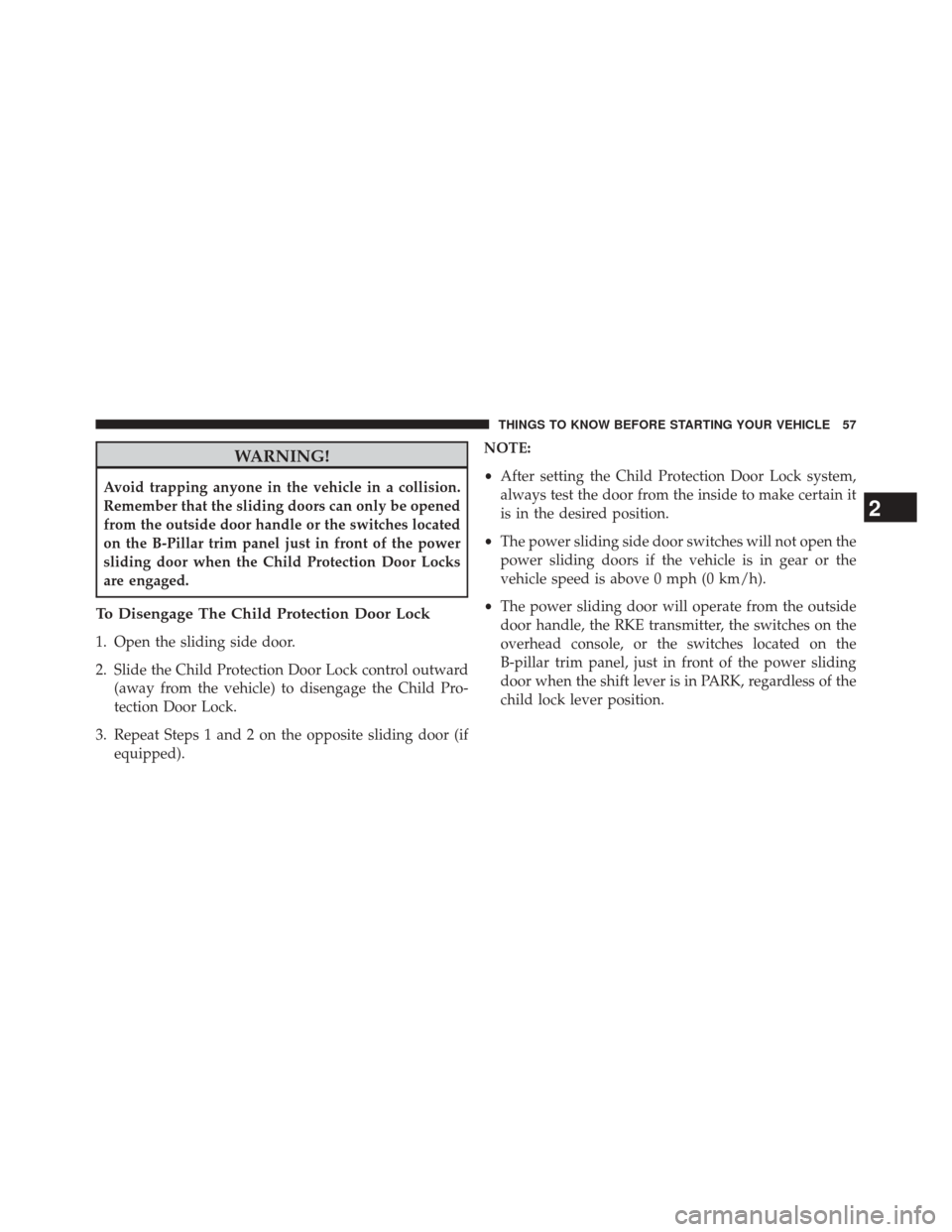
WARNING!
Avoid trapping anyone in the vehicle in a collision.
Remember that the sliding doors can only be opened
from the outside door handle or the switches located
on the B-Pillar trim panel just in front of the power
sliding door when the Child Protection Door Locks
are engaged.
To Disengage The Child Protection Door Lock
1. Open the sliding side door.
2. Slide the Child Protection Door Lock control outward(away from the vehicle) to disengage the Child Pro-
tection Door Lock.
3. Repeat Steps 1 and 2 on the opposite sliding door (if equipped). NOTE:
•
After setting the Child Protection Door Lock system,
always test the door from the inside to make certain it
is in the desired position.
• The power sliding side door switches will not open the
power sliding doors if the vehicle is in gear or the
vehicle speed is above 0 mph (0 km/h).
• The power sliding door will operate from the outside
door handle, the RKE transmitter, the switches on the
overhead console, or the switches located on the
B-pillar trim panel, just in front of the power sliding
door when the shift lever is in PARK, regardless of the
child lock lever position.
2
THINGS TO KNOW BEFORE STARTING YOUR VEHICLE 57
Page 64 of 703
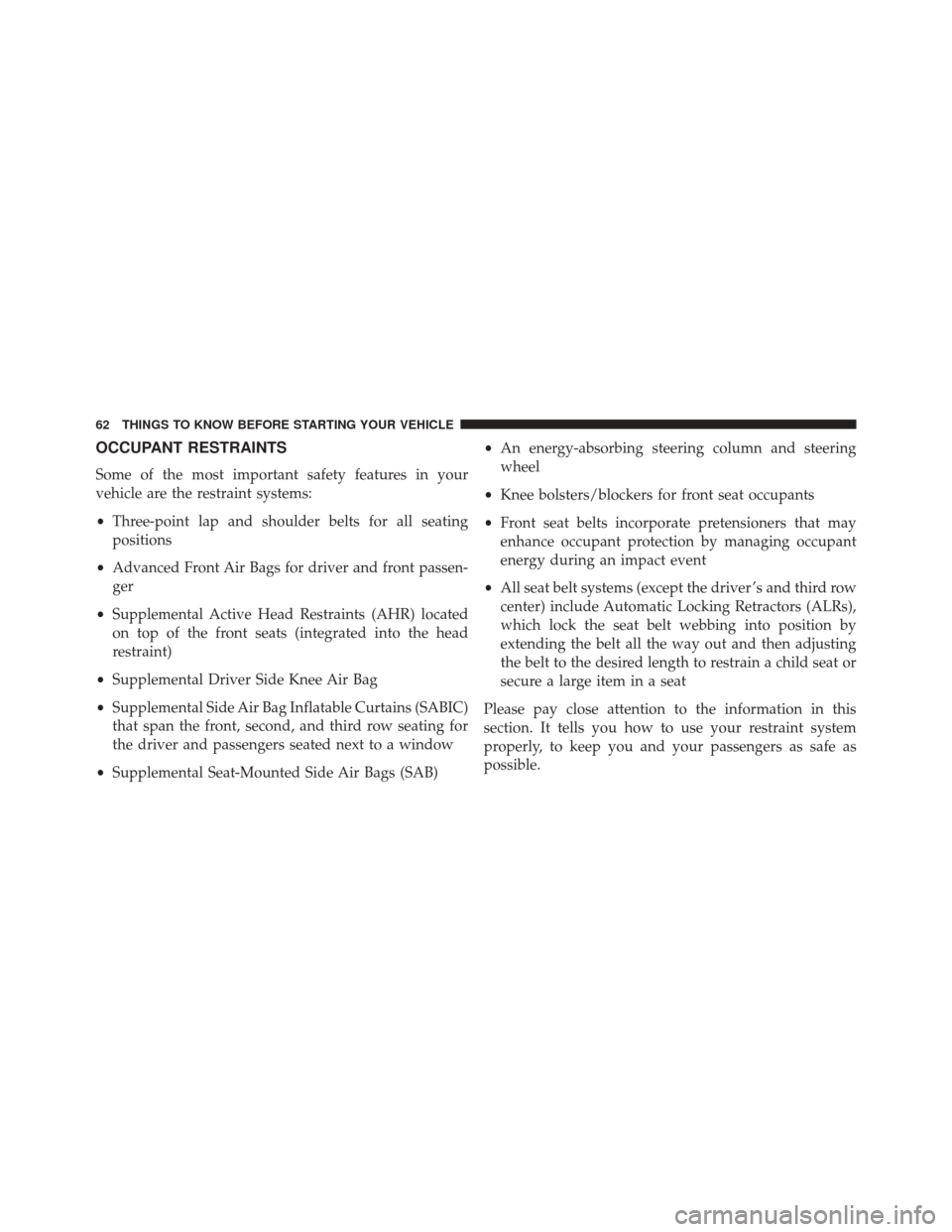
OCCUPANT RESTRAINTS
Some of the most important safety features in your
vehicle are the restraint systems:
•Three-point lap and shoulder belts for all seating
positions
• Advanced Front Air Bags for driver and front passen-
ger
• Supplemental Active Head Restraints (AHR) located
on top of the front seats (integrated into the head
restraint)
• Supplemental Driver Side Knee Air Bag
• Supplemental Side Air Bag Inflatable Curtains (SABIC)
that span the front, second, and third row seating for
the driver and passengers seated next to a window
• Supplemental Seat-Mounted Side Air Bags (SAB) •
An energy-absorbing steering column and steering
wheel
• Knee bolsters/blockers for front seat occupants
• Front seat belts incorporate pretensioners that may
enhance occupant protection by managing occupant
energy during an impact event
• All seat belt systems (except the driver ’s and third row
center) include Automatic Locking Retractors (ALRs),
which lock the seat belt webbing into position by
extending the belt all the way out and then adjusting
the belt to the desired length to restrain a child seat or
secure a large item in a seat
Please pay close attention to the information in this
section. It tells you how to use your restraint system
properly, to keep you and your passengers as safe as
possible.
62 THINGS TO KNOW BEFORE STARTING YOUR VEHICLE
Page 74 of 703
As a guide, if you are shorter than average you will
prefer a lower position, and if you are taller than average
you will prefer a higher position. When you release the
anchorage, try to move it up or down to make sure that
it is locked in position.
Seat Belts In Passenger Seating Positions
The seat belts in the passenger seating positions are
equipped with an Automatic Locking Retractor (ALR) or
a cinching latch plate which are used to secure a child
restraint system. For additional information refer to
“Installing Child Restraints Using the Vehicle Seat Belt”
under the “Child Restraint” section. The chart below
defines the type of feature for each seating position.
Second Row Bench Seat
Driver Center Passenger
First Row N/A N/A ALR
Second Row Bench Seat- ing ALR ALR N/A
Third Row ALR Cinch ALR
Second Row Quad Seating
Driver Center Passenger
First Row N/A N/A ALR
Second Row Quad Seat- ing ALR N/A ALR
Third Row ALR Cinch ALR
72 THINGS TO KNOW BEFORE STARTING YOUR VEHICLE
Page 75 of 703
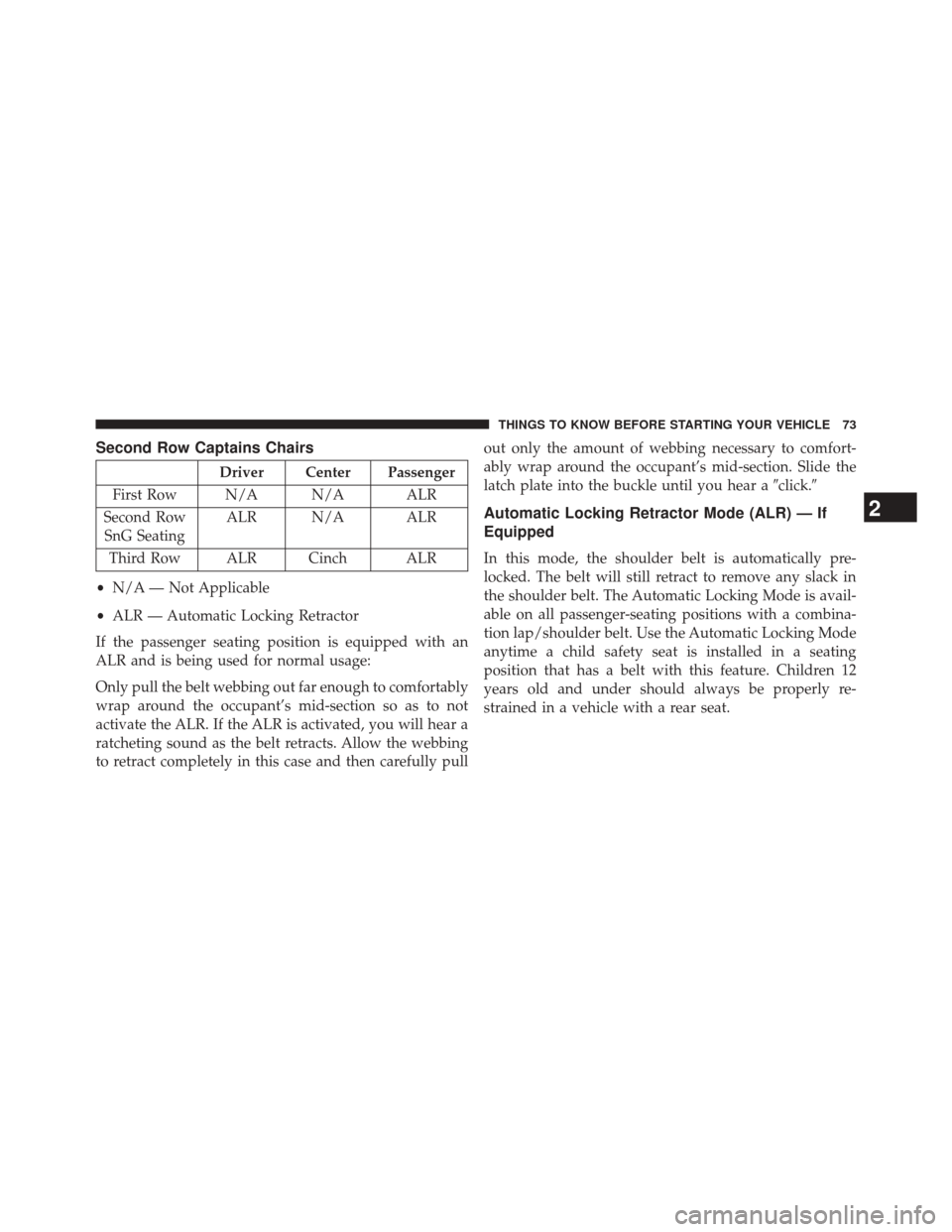
Second Row Captains Chairs
Driver Center Passenger
First Row N/A N/A ALR
Second Row SnG Seating ALR N/A ALR
Third Row ALR Cinch ALR
• N/A — Not Applicable
• ALR — Automatic Locking Retractor
If the passenger seating position is equipped with an
ALR and is being used for normal usage:
Only pull the belt webbing out far enough to comfortably
wrap around the occupant’s mid-section so as to not
activate the ALR. If the ALR is activated, you will hear a
ratcheting sound as the belt retracts. Allow the webbing
to retract completely in this case and then carefully pull out only the amount of webbing necessary to comfort-
ably wrap around the occupant’s mid-section. Slide the
latch plate into the buckle until you hear a
�click.�
Automatic Locking Retractor Mode (ALR) — If
Equipped
In this mode, the shoulder belt is automatically pre-
locked. The belt will still retract to remove any slack in
the shoulder belt. The Automatic Locking Mode is avail-
able on all passenger-seating positions with a combina-
tion lap/shoulder belt. Use the Automatic Locking Mode
anytime a child safety seat is installed in a seating
position that has a belt with this feature. Children 12
years old and under should always be properly re-
strained in a vehicle with a rear seat.
2
THINGS TO KNOW BEFORE STARTING YOUR VEHICLE 73
Page 94 of 703
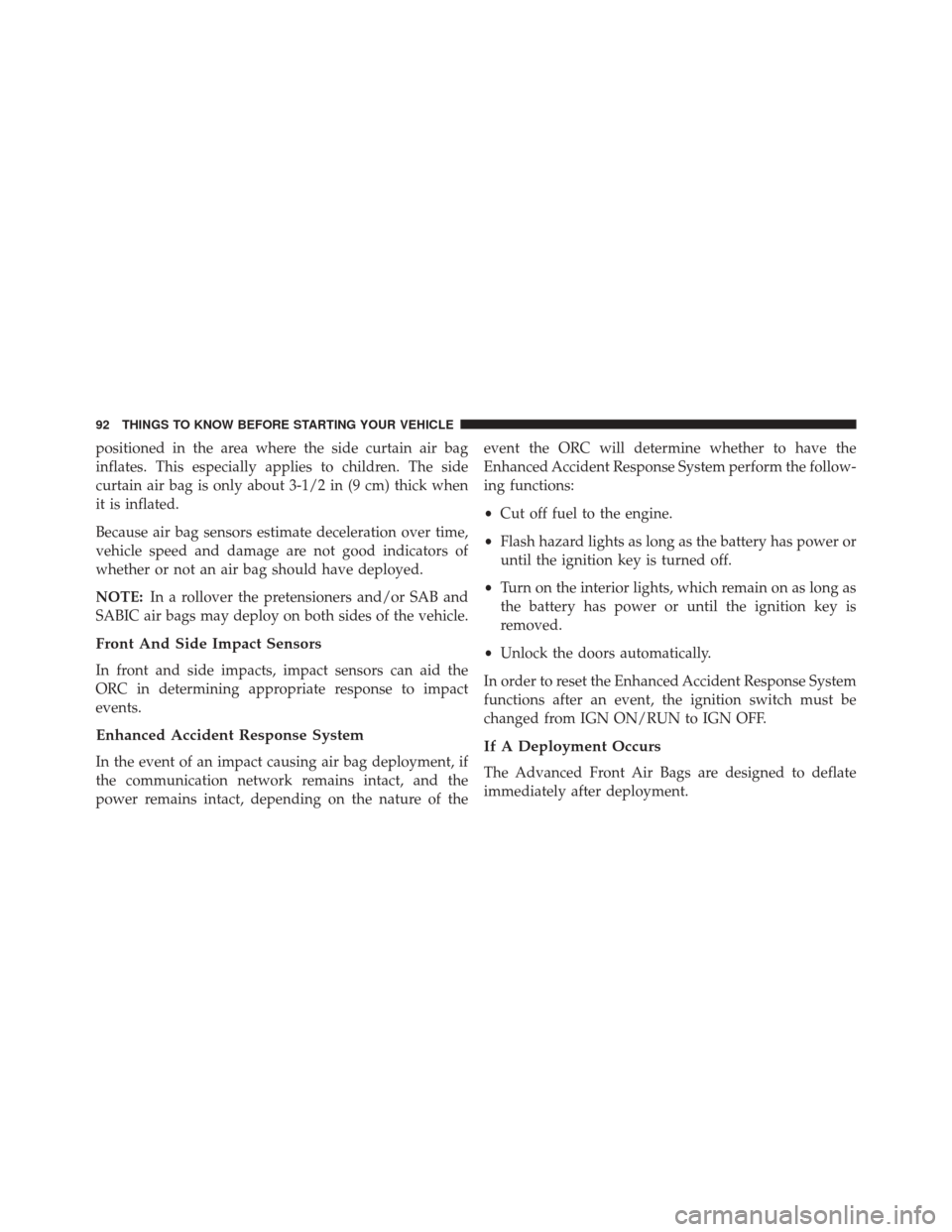
positioned in the area where the side curtain air bag
inflates. This especially applies to children. The side
curtain air bag is only about 3-1/2 in (9 cm) thick when
it is inflated.
Because air bag sensors estimate deceleration over time,
vehicle speed and damage are not good indicators of
whether or not an air bag should have deployed.
NOTE:In a rollover the pretensioners and/or SAB and
SABIC air bags may deploy on both sides of the vehicle.
Front And Side Impact Sensors
In front and side impacts, impact sensors can aid the
ORC in determining appropriate response to impact
events.
Enhanced Accident Response System
In the event of an impact causing air bag deployment, if
the communication network remains intact, and the
power remains intact, depending on the nature of the event the ORC will determine whether to have the
Enhanced Accident Response System perform the follow-
ing functions:
•
Cut off fuel to the engine.
• Flash hazard lights as long as the battery has power or
until the ignition key is turned off.
• Turn on the interior lights, which remain on as long as
the battery has power or until the ignition key is
removed.
• Unlock the doors automatically.
In order to reset the Enhanced Accident Response System
functions after an event, the ignition switch must be
changed from IGN ON/RUN to IGN OFF.If A Deployment Occurs
The Advanced Front Air Bags are designed to deflate
immediately after deployment.
92 THINGS TO KNOW BEFORE STARTING YOUR VEHICLE
Page 111 of 703
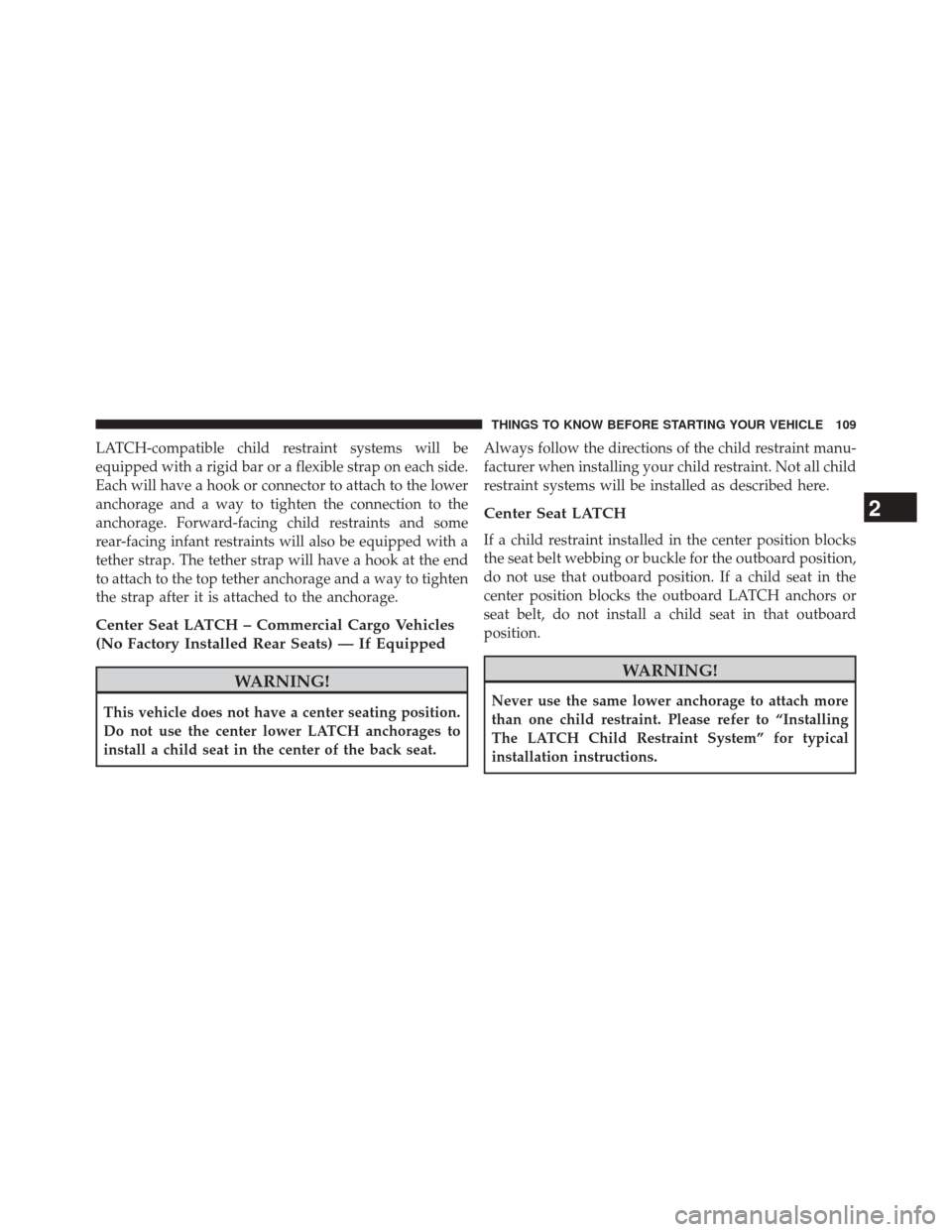
LATCH-compatible child restraint systems will be
equipped with a rigid bar or a flexible strap on each side.
Each will have a hook or connector to attach to the lower
anchorage and a way to tighten the connection to the
anchorage. Forward-facing child restraints and some
rear-facing infant restraints will also be equipped with a
tether strap. The tether strap will have a hook at the end
to attach to the top tether anchorage and a way to tighten
the strap after it is attached to the anchorage.
Center Seat LATCH – Commercial Cargo Vehicles
(No Factory Installed Rear Seats) — If Equipped
WARNING!
This vehicle does not have a center seating position.
Do not use the center lower LATCH anchorages to
install a child seat in the center of the back seat.Always follow the directions of the child restraint manu-
facturer when installing your child restraint. Not all child
restraint systems will be installed as described here.
Center Seat LATCH
If a child restraint installed in the center position blocks
the seat belt webbing or buckle for the outboard position,
do not use that outboard position. If a child seat in the
center position blocks the outboard LATCH anchors or
seat belt, do not install a child seat in that outboard
position.
WARNING!
Never use the same lower anchorage to attach more
than one child restraint. Please refer to “Installing
The LATCH Child Restraint System” for typical
installation instructions.
2
THINGS TO KNOW BEFORE STARTING YOUR VEHICLE 109
Page 112 of 703
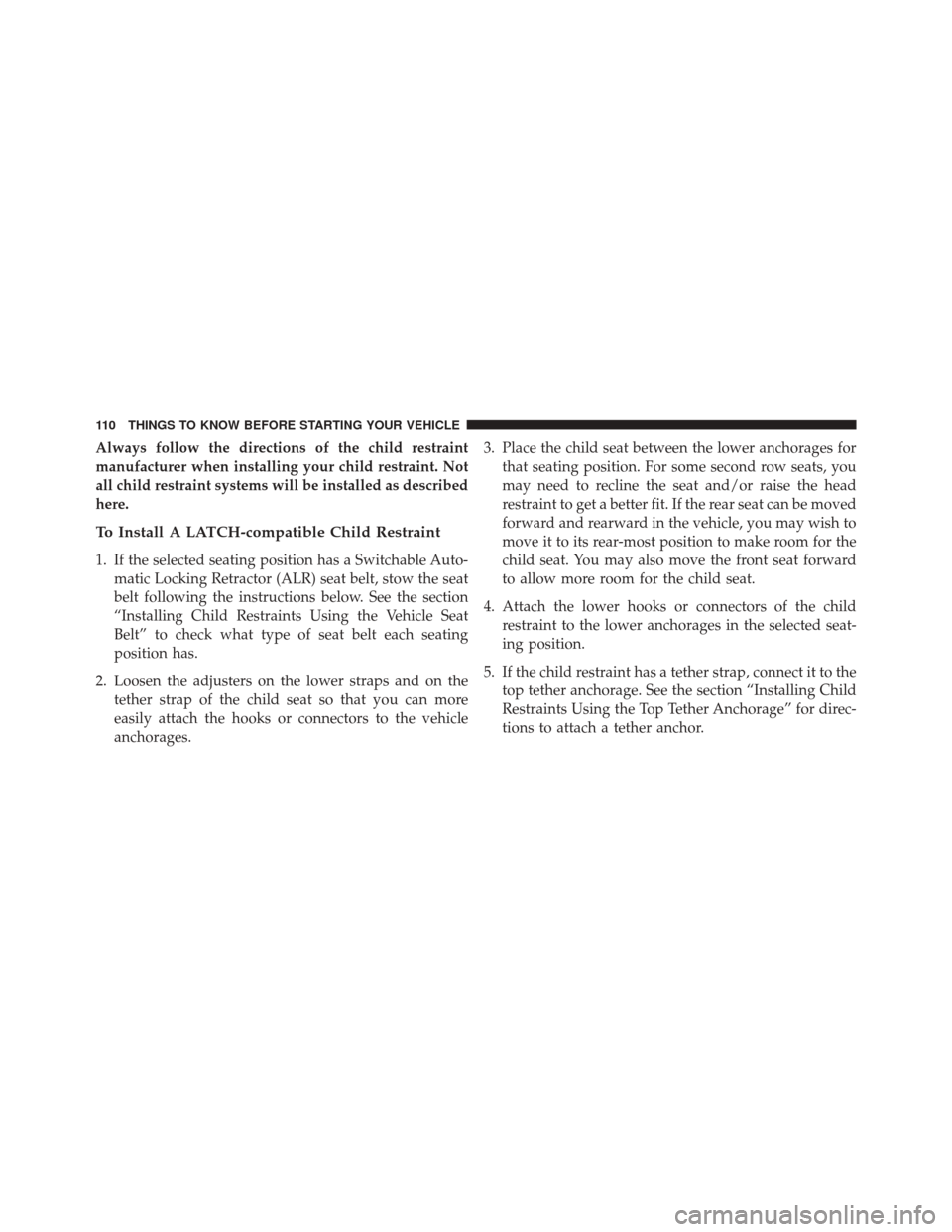
Always follow the directions of the child restraint
manufacturer when installing your child restraint. Not
all child restraint systems will be installed as described
here.
To Install A LATCH-compatible Child Restraint
1. If the selected seating position has a Switchable Auto-matic Locking Retractor (ALR) seat belt, stow the seat
belt following the instructions below. See the section
“Installing Child Restraints Using the Vehicle Seat
Belt” to check what type of seat belt each seating
position has.
2. Loosen the adjusters on the lower straps and on the tether strap of the child seat so that you can more
easily attach the hooks or connectors to the vehicle
anchorages. 3. Place the child seat between the lower anchorages for
that seating position. For some second row seats, you
may need to recline the seat and/or raise the head
restraint to get a better fit. If the rear seat can be moved
forward and rearward in the vehicle, you may wish to
move it to its rear-most position to make room for the
child seat. You may also move the front seat forward
to allow more room for the child seat.
4. Attach the lower hooks or connectors of the child restraint to the lower anchorages in the selected seat-
ing position.
5. If the child restraint has a tether strap, connect it to the top tether anchorage. See the section “Installing Child
Restraints Using the Top Tether Anchorage” for direc-
tions to attach a tether anchor.
110 THINGS TO KNOW BEFORE STARTING YOUR VEHICLE
Page 113 of 703
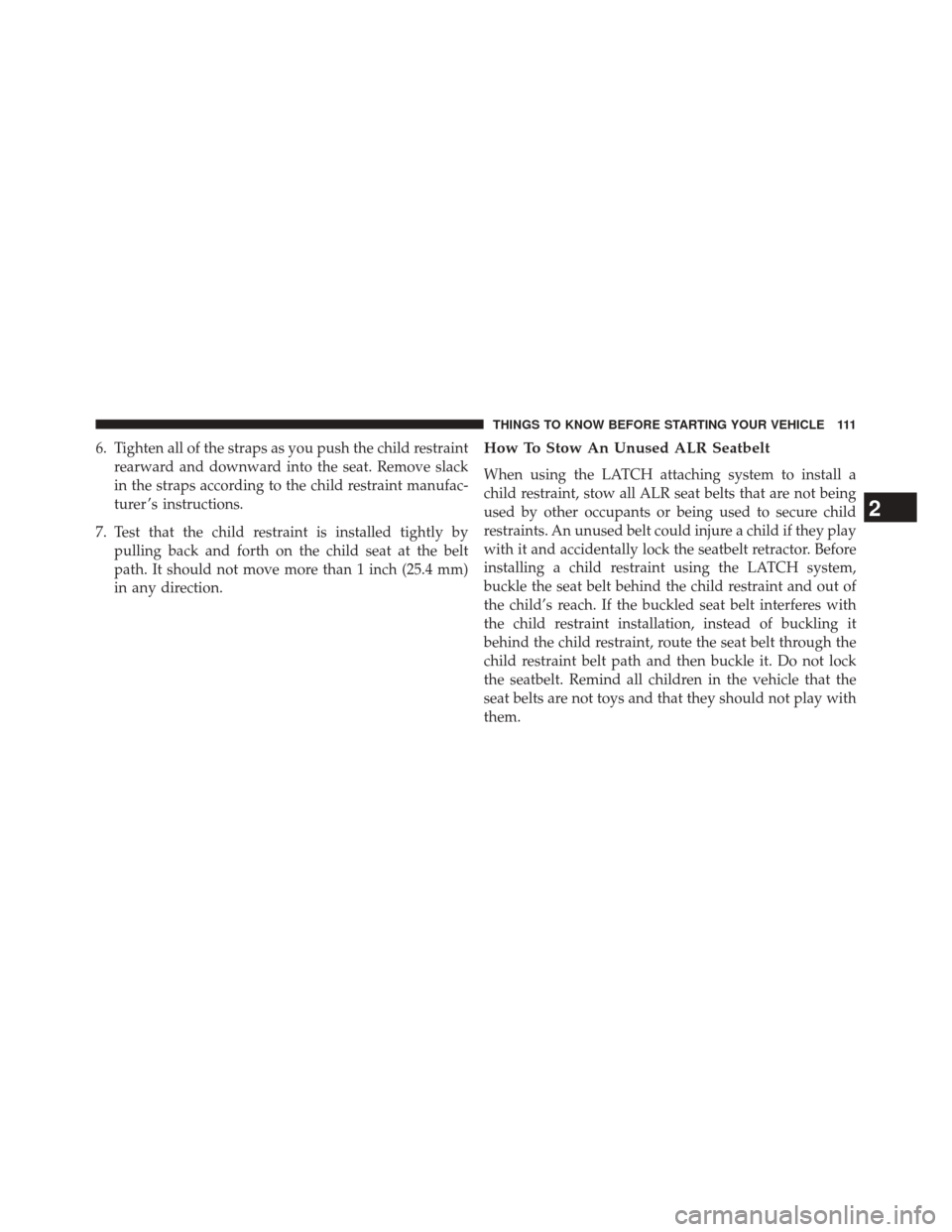
6. Tighten all of the straps as you push the child restraintrearward and downward into the seat. Remove slack
in the straps according to the child restraint manufac-
turer ’s instructions.
7. Test that the child restraint is installed tightly by pulling back and forth on the child seat at the belt
path. It should not move more than 1 inch (25.4 mm)
in any direction.How To Stow An Unused ALR Seatbelt
When using the LATCH attaching system to install a
child restraint, stow all ALR seat belts that are not being
used by other occupants or being used to secure child
restraints. An unused belt could injure a child if they play
with it and accidentally lock the seatbelt retractor. Before
installing a child restraint using the LATCH system,
buckle the seat belt behind the child restraint and out of
the child’s reach. If the buckled seat belt interferes with
the child restraint installation, instead of buckling it
behind the child restraint, route the seat belt through the
child restraint belt path and then buckle it. Do not lock
the seatbelt. Remind all children in the vehicle that the
seat belts are not toys and that they should not play with
them.
2
THINGS TO KNOW BEFORE STARTING YOUR VEHICLE 111